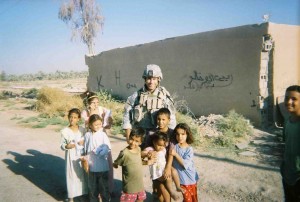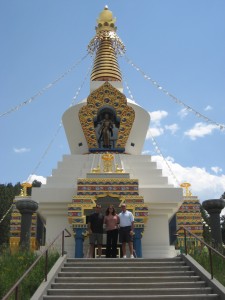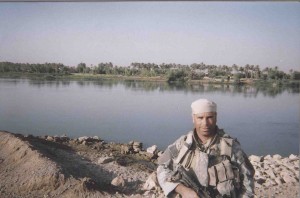Sunday
Featured StoriesWalking the Tiger’s Path
In 2005 Sergeant Paul Kendel, an American Georgia National Guardsman stationed in Iraq, disillusioned with the American mission and with the aggression starting to overwhelm his military unit, began email contact with Margot Neuman, executive director of the Ratna Prison Initiative. The Dot eventually excerpted some of their emails, which later became teaching material for Pema Chodron and Shambhala President, Richard Reoch, in their “Practicing Peace in Times of War” programs and Pema’s book of the same name.
Since returning from Iraq, Paul has further developed his connection to the Shambhala sangha and, inspired by his email exchange with Margot, has completed a memoir detailing his experiences discovering the dharma in a war zone called Walking the Tiger’s Path: A Soldier’s Spiritual Journey in Iraq.
Sergeant Kendel’s story has also inspired Ratna Prison Initiative to begin developing a secular meditation program for combat veterans, with a pilot program beginning with incarcerated veterans (possibly in co-operation with Stanford University Medical School).
In December 2008, Paul Kendel attended a weekthun at Shambhala Mountain Center. He currently works as a teacher in a Florida reformatory, but has begun training with his National Guard unit for assignment to Afghanistan this spring.
What follows is an excerpt from Walking the Tiger’s Path, which takes place after a Bradley Fighting Vehicle spills over into a ditch, drowning a soldier, Sergeant Mercer.
When the sun rose, the farmers and general population began driving to their various destinations for the day. The recovery crew arrived and began attaching tow cables to pull the Bradley out of the ditch. At that moment a car drove up to our security checkpoint and came too close. I was still pissed off over Mercer’s death. I thought things should’ve been handled quicker, that the helicopter should’ve arrived and landed faster. At this point we were still recently deployed; I’d yet to fire my weapon. I walked toward the car with my hand in the air motioning for him to stop. I waited a couple of seconds, but the car inched closer. This was precisely what a suicide bomber might do: find a congregation of soldiers that he could drive into and detonate his explosive-packed trunk. I thought I might have to fire, but wondered if I’d be seen by the leadership above me as over-zealous. The car then inched ahead a little further.
Suddenly feeling that it would relieve me of my anguish and anger over Mercer’s death, I decided to fire. I discharged three rounds in the dirt to the left of the car to make it stop. Private Baker, standing guard next to me, fired off two rounds of his own as insurance. For a fleeting moment I believed firing at that car had placated my anger over Mercer. The violent gesture created a moment of relief. Behind me the Battalion Commander’s PSD (personal security detail), who’d accompanied the Colonel outside Camp Stryker to view Mercer’s Bradley, began cheering and shouting things like, Fuck, yeah! Shoot the fucker! That’s what I’m talking about! My aggressive outburst was clearly well received. Suddenly I was surrounded in approval. I felt exultant. However, none of these people had held Mercer’s hand the night before, hoping for him to spit out enough mud so he’d breathe again, so he’d open his eyes and live but they were just excited to see a little action.
I looked at the Iraqi’s face, his eyes wide with fear. He quickly put the car in reverse, backing away about two hundred feet, wheeling around, and driving off down a different road. This man was just a farmer trying to get to work, nothing more. My high began to recede. I returned back up the road with Baker toward the humvees [a type of military vehicle] and the rest of my section. My platoon sergeant, SFC [Sergeant First Class] Janes looked at Private Baker and asked, “Which of you fired first?” He clearly assumed Baker was more likely to have taken the aggressive action against the driver.
Baker shrugged at Janes. “It wasn’t me. It was Sergeant Kendel.”
Janes looked a little taken aback. He didn’t expect a “California liberal” to take such aggressive action. I felt pleased that I’d dispelled some preconceptions about me, but I felt hollow. I remembered a passage I’d just read in the Sakyong’s book, Turning the Mind into an Ally, where he’s in India trapped behind a truck, ground to a halt in traffic, frustrated and angry that the truck ahead of him isn’t moving as the traffic grinds on for hours – and then finally the traffic opens up, and they pass the truck, and when he sees that the truck driver was also stuck in traffic, just trying to make a living, he sees the pointlessness of anger at this innocent guy going about his life.
Even though I had to fire on the man for genuine security reasons, the thrill of the gunfire dissolved into guilt. I’d directed all that anger and frustration at an innocent man. What if I’d hit him by mistake? I realized I’d succumbed to aggression easily and automatically, and wasn’t proud of it. Arrogantly, I’d believed I was a cut above others, that I wouldn’t so easily slip into the pitfall of hatred. I thought I was more balanced and rational than that, but suddenly I realized that it wasn’t true.
Editor’s Note: We are currently on hiatus from publishing new articles; in the meantime, please enjoy this classic item reprinted from our back issues.







